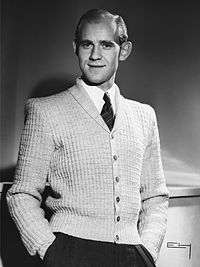Cardigan (sweater)


A cardigan is a type of knitted garment that has an open front. Commonly cardigans have buttons: a garment that is tied is instead considered a robe. A more modern version of the garment has no buttons and hangs open by design. By contrast, a pullover does not open in front but must be "pulled over" the head to be worn. It may be machine- or hand-knitted.
The cardigan was named after James Brudenell, 7th Earl of Cardigan, a British Army Major General who led the Charge of the Light Brigade at the Battle of Balaclava during the Crimean War. It is modelled after the knitted wool waistcoat that British officers supposedly wore during the war. The legend of the event and the fame that Lord Cardigan achieved after the war led to the rise of the garment's popularity.[1][2] The term originally referred only to a knitted sleeveless vest, but expanded to other types of garment over time. Coco Chanel is credited with popularizing cardigans for women because "she hated how tight-necked men’s sweaters messed up her hair when she pulled them over her head."[3] The garment is mostly associated with the college culture of the Roaring Twenties and early 1930s, being also popular throughout the 1950s, the 1970s and the 1990s. Cardigans have also regained popularity during the present decade.
Plain cardigans are often worn over shirts and inside suit jackets as a less formal version of the waistcoat or vest that restrains the necktie when the jacket has been removed. Its versatility means it can be worn in casual or formal settings and in any season, but it is most popular during cool weather.
Monochromatic cardigans, in sleeved or vest form, may be viewed as a conservative fashion staple. As an item of formal clothing for any gender, it is worn over a button-down dress shirt. A less formal style is a T-shirt underneath.
In popular culture
- Singer Perry Como wore cardigans on his TV musical-variety show, The Perry Como Show, which ran from 1955-59 on the NBC-TV network. The sweaters complemented his easy-going style of singing, and became a trademark.[4][5][6]
- Fred Rogers, star of the long-running children's television program Mister Rogers' Neighborhood (1963-2001), would, at the beginning of each episode, come in through the front door, remove his jacket and hang it up in a closet, take out a cardigan and put it on. The sweater became a trademark for him as well. His cardigans were made by his mother and were closed with a zipper instead of buttons.
- Paul Michael Glaser often wore a cardigan sweater as "David Michael Starsky", one half of Starsky & Hutch in the 1975-79 TV series.
- Kurt Cobain, the singer, guitar player, and primary song writer for the grunge rock band Nirvana, was known to wear vintage "grandpa style" cardigans. The cardigan he wore during MTV's 1993 Nirvana Unplugged concert sold at auction in Los Angeles for $137,500 in November, 2015. The sweater was reported to have a burn hole, a button missing, and discoloration around the pockets.[7][8]
- Grandpa's Cardigan is a 1993 children's book by Joy Watson.[9]
- Jeff Bridges "The dude", wore his iconic, light brown, patterned cardigan in the 1998 film "The big Lebowski[10]".
See also
References
- ↑ The Cardigan Sweater website, accessed 10 March 2010
- ↑ David, Saul (1997) The Homicidal Earl: The Life of Lord Cardigan. London: Little, Brown. pp. 431-436. ISBN 0316641650
- ↑ Geller, Allison (24 June 2016). "The Military Origins of the Cardigan". The Atlantic. Retrieved 24 June 2016.
- ↑ Brooks, Tim; Marsh, Earle F., eds. (1987), The Complete Directory to Prime Time Network and Cable TV Shows, Ballantine Books, pp. 1071–1072, ISBN 0-345-49773-2, retrieved 14 April 2010
- ↑ Denisova, Maria. "Como, Perry". Pennsylvania Center for the Book, Pennsylvania State University. Retrieved April 4, 2010.
- ↑ Philbin, Regis (October 18, 1991). "DVD: The Best of Perry Como: Volume One (review)". Entertainment Weekly. Retrieved April 30, 2010.
- ↑ Grossman, Samantha (November 5, 2015) "Kurt Cobain';s Unplugged Sweater Sells for $137,500" Time
- ↑ Garcia, Patricia (November 9, 2015) "Kurt Cobain’s MTV Unplugged Cardigan Sold for $137,500" Vogue
- ↑ Watson, Joy - bookcouncil
- ↑ Coen, Joel; Coen, Ethan (1998-03-06), The Big Lebowski, retrieved 2016-11-02
External links
 Media related to Cardigan (sweater) at Wikimedia Commons
Media related to Cardigan (sweater) at Wikimedia Commons